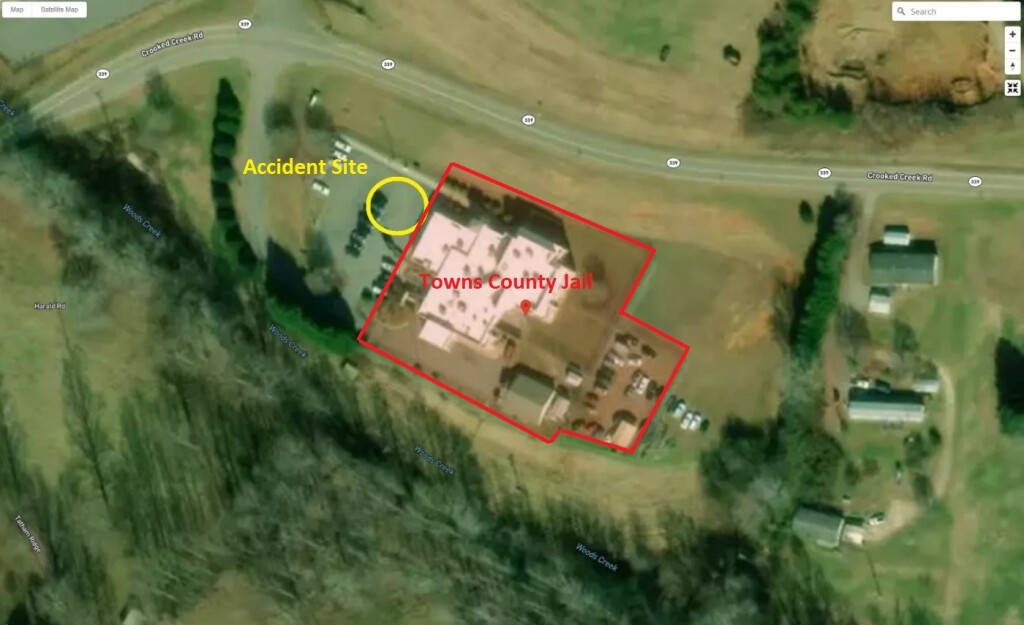DJI Matrice 300 UAS/RPAS Pilot Injured in US Prison Geo-fence Incident
On 6 May 2021 a DJI Matrice 300 Unmanned Air System (UAS) /Remotely Powered Air System (RPAS) / quadcopter drone was involved in an accident near Young Harris, Georgia. This was during a demonstration flight to a potential customer carrying a Zenmuse H20T camera and a Wingsland Z15 spotlight. The remote pilot in command (RPIC) sustained serious injuries.
The US National Transportation Safety Board (NTSB) explain in their preliminary report that the flight location was very close to a ‘DJI GEO Zone‘ designated as a geo-fenced ‘Restricted Zone.’ The RPIC was apparently not aware of that geofencing (shown in red below), but it is clear from the NTSB report and check of digital mapping that the flight was conducted in the car park of what is Towns County Jail.

DJI Matrice 300 Accident Site Outside Towns County Jail, Georgia (Credit: via NTSB with added notation)
NTSB state:
The RPIC stated that he performed a normal takeoff and flew the drone to the west over a wooded area… He stated that during the spotlight demonstration the drone was unresponsive to control inputs, so he utilized the return-to-home (RTH) function. During the RTH descent toward the home point the drone hovered about 7 ft agl over a vehicle in the parking lot and was still unresponsive to any control inputs.
When the drone would not land, the RPIC grabbed onto the landing gear and attempted to physically move the drone away from the vehicle. The drone resisted the physical displacement and maintained its position over the vehicle. The RPIC requested assistance from a demonstration attendee and handed him the remote controller. With guidance from the RPIC, he attempted several times to shut down the motors while RPIC held onto the landing gear with both hands. Finally, the RPIC attempted to remove the drone batteries when a propeller blade struck his right hand several times, which caused tendon and nerve damage. [T]he RPIC continued to hold onto the drone for several minutes until the batteries were exhausted and the motors stopped.
Recorded data for the flight was retrieved:.
A preliminary review of the flight logs showed that the RTH function was initiated about 7 minutes into the flight at 393 ft agl. A Restricted Zone notification was issued two times on the remote controller during the RTH procedure.
NTSB Probable Cause (UPDATE: 19 August 2022)
The remote pilot-in-command’s (RPIC) decision to physically hold onto the drone’s landing gear in flight, which resulted in the rotors striking his hand and causing serious injury. Contributing to the accident was the RPIC’s inadequate preflight planning and lack of airspace awareness.
NTSB note that:
The RPIC could have manually landed the drone if he had exited RTH mode. Also, the pilot should have discovered the restricted zone during preflight planning and used a landing zone and home point farther away from the restricted zone.
Safety Resources
You may also find these Aerossurance articles of interest:
- Drone Goes Walkabout: Hemispherical Human Factors Hiccup
- Software Bug and High Winds Down Drone
- Facebook Aquila Drone Accident: Gust Induced Structural Failure
- Drone Operation Injury
- Inspection UAS Collides with PNG LNG Export Jetty
- USAF MQ-9A Reaper Lever Confusion: Human Factors
- UPDATE 4 August 2022: Schiebel Camcopter S-100 Engine Failure Results in Baltic Crash

Recent Comments